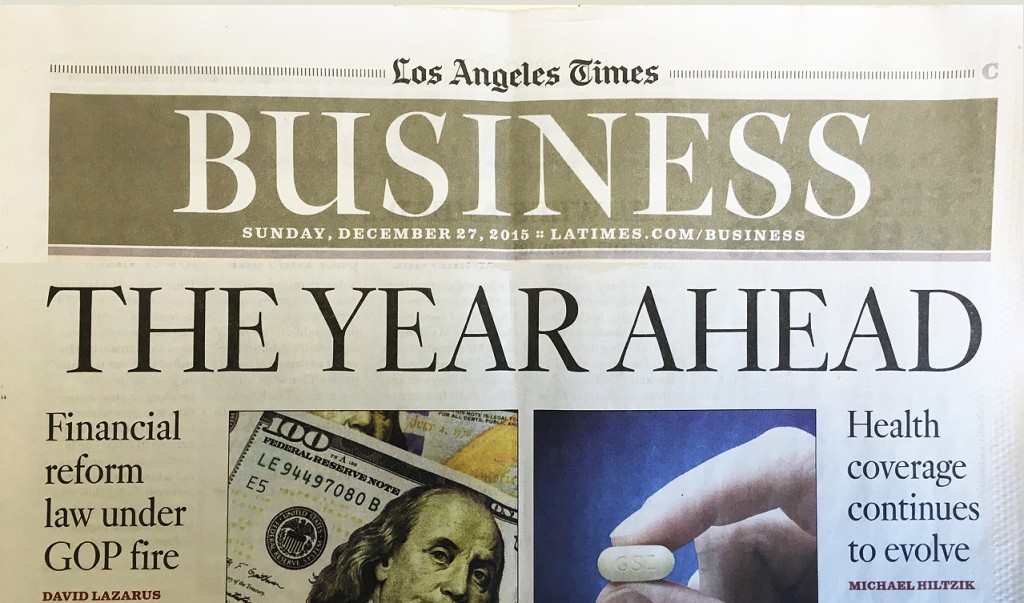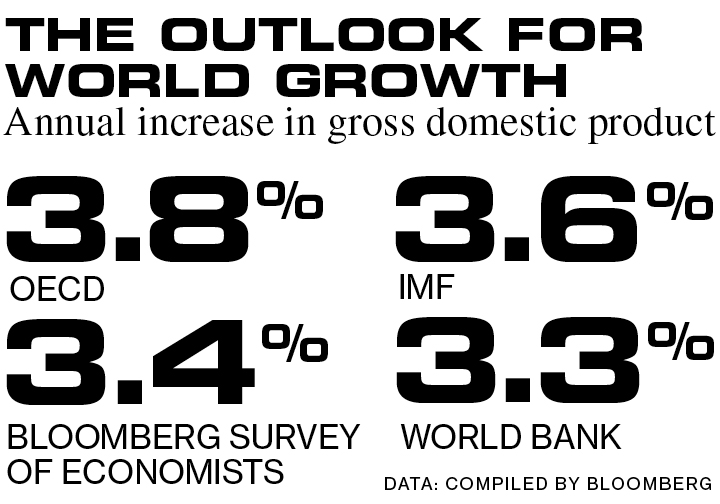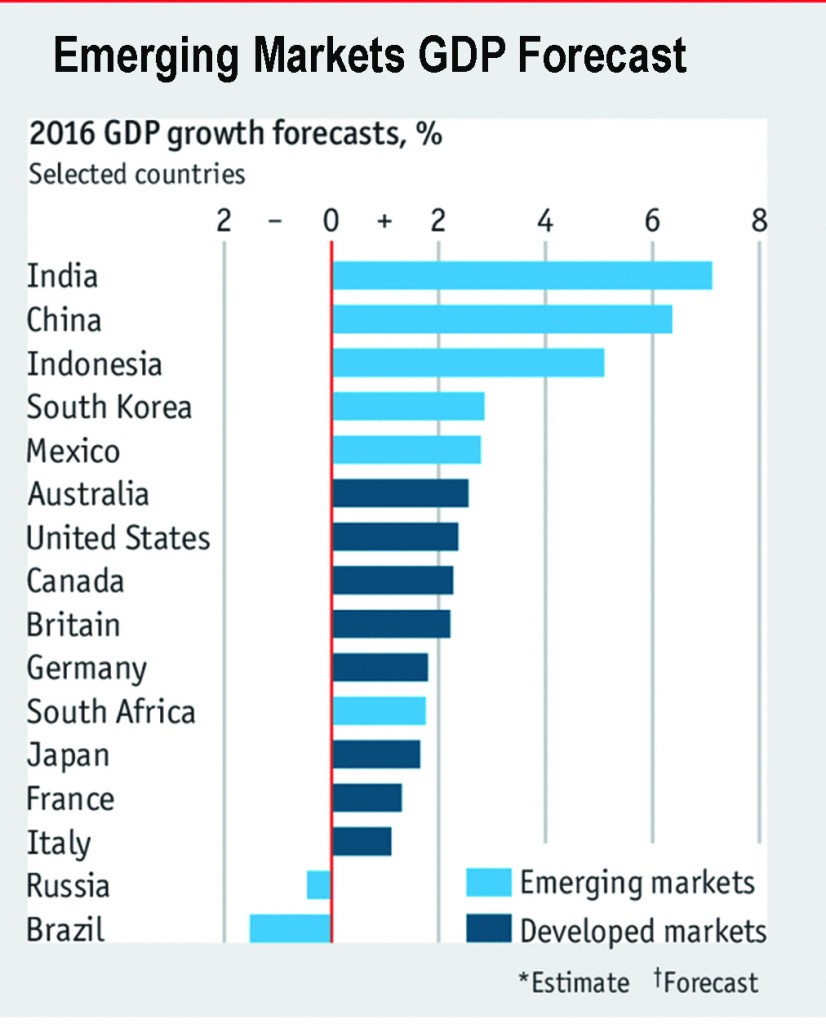by Mark Schniepp
January 2016
 Source: LA Times, December 27, 2015, page C1
Source: LA Times, December 27, 2015, page C1
What you should know about 2016
Because world economic events have so much more influence on our own domestic growth, job creation, and the rise in income, monitoring the outlook for the principal economies in the world is a critical factor in predicting the probable performance of the U.S. economy in 2016.
The Panama Canal will be wider when a third set of locks opens in April. Ships twice the size of what traverse the canal today will be accommodated. U.S. Ports are now gearing up for the traffic. Will there be enough global demand to fill the canal this year?
Keep in mind that the presidential election occurs on November 8, 2016. There are also major elections in Japan, Germany, the United Kingdom, and China this year.
The Summer Olympics in Rio de Janeiro, Brazil begin on August 5th.
The United Kingdom votes on a referendum in October on whether to remain in the European Union. Leaving would free the U.K. to purse it’s own trade deals with faster growing economies than the sluggish European economy presently. It would also impose tariffs on 90 percent of its exports to the existing European Union. Staying gives the U.K. open access to the broader European market of 500 million people.
World economic growth is projected to be 3.5 percent in 2016, an improvement from the 3.0 percent recorded in 2015.[1] Other sources put world economic growth at 2.7 percent for 2016, stating that “2016 will be another year of repair, recovery, reform and risk for most countries.[2]”
This latter view is supported by China’s sinking GDP growth, which will continue to decelerate. Consequently, global demand for goods and materials will remain soft. We therefore expect interest rates to remain low (despite the threat of tighter monetary policy by the Federal Reserve) along with the prices of oil and other commodities. World inflation will be less than 2.0 percent, and probably closer to one percent in Europe and Japan.
 Source: Bloomberg
Source: Bloomberg
Bad weather is predicted around the Pacific Rim due to the strong El Nino that is present today. This could mean major disruptions from storms and floods. Major disruptions tend to produce sell-offs in world financial markets. The California coastline is also vulnerable to some degree of carnage this winter.
The U.S. economy will have very low unemployment and very low inflation in 2016. And while we have been predicting higher wage and salary growth this year, it’s not likely to accelerate beyond an average of about 3 percent.
American families have paid off debt since the Great Recession, and there is pent-up demand, particularly for housing. As millennials move out of their bedrooms at their parent’s homes, the housing market will be impacted. For now, it’s the apartment market with vacancy rates throughout the nation falling to record lows. Over the next 5 years, it will be the first time home buyer market. Interest rates will be a determining factor as to how robust the housing market will be in coming years.
Few economists expect a major slowdown in 2016, let alone a recession. There’s little reason to think the conventional wisdom is wrong this time around. The question is whether 2016 will be a true turning point in the world economy and the best year of the current economic cycle.
Risks in 2016
Most of the risks lie with the international economy, with the largest uncertainty resting on China and Europe.
For U.S. exports to contribute positively to overall domestic growth, both China and Europe need to be healthy. And for Europe to avoid risk of a further slowdown, emerging market growth needs to improve. Historically emerging market nations have been important for European exports. Weakness in these markets would produce more than proportional downside risks to the world economy.
 Source: Economist Intelligence Unit, The Economist, December 30, 2015
Source: Economist Intelligence Unit, The Economist, December 30, 2015
Backed by lower oil prices, a weaker euro, and quantitative easing by the European Central Bank, Europe’s GDP growth is expected to reach 1.5 percent with inflation of around 1 percent during the year.
If European and global markets remain calm, Europe will continue its recovery. But any of a number of shocks, whether a hard landing in China, debt problems in Europe, El Nino disruptions, or terrorist disruptions, will create substantial pressure on policymakers at a time when the constraints on their ability to act are already intense.
[1] The International Monetary Fund, the World Bank, and Bloomberg, November 2015.
[2] The Economist Economic Intelligence Unit, December 30, 2015.
__________________________________
Upcoming Economic Forecast Conferences in 2016
2016 Ventura County
February 5, 2016
Westlake Hyatt
Register Now
2016 Santa Clarita Valley
March 10, 2016
Valencia Hyatt
Register Now
2016 Orange County (In Partnership with the UCLA Anderson Forecast)
April 2016
UC Irvine
2016 San Diego County (In Partnership with the UCLA Anderson Forecast)
Date TBD
The California Economic Forecast is an economic consulting firm that produces commentary and analysis on the U.S. and California economies. The firm specializes in economic forecasts and economic impact studies, and is available to make timely, compelling, informative and entertaining economic presentations to large or small groups.



